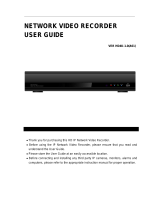
1 VMAX IP Plus™ User Manual
Table of Contents
1. GETTING STARTED ................................................................................................................................ 2
1.1 CHECKING SUPPLIED ITEMS ..................................................................................................................................... 2
1.2 SYSTEM STARTUP ...................................................................................................................................................... 3
1.3 SYSTEM SHUTDOWN ................................................................................................................................................. 3
1.4 SYSTEM EXPLANATION ............................................................................................................................................. 4
2. STARTUP WIZARD ................................................................................................................................. 8
2.1 LANGUAGE ................................................................................................................................................................. 8
2.2 DATE/TIME ................................................................................................................................................................. 8
2.3 HDD FORMAT ........................................................................................................................................................... 9
2.4 NETWORK................................................................................................................................................................. 10
2.5 CAMERA MANAGEMENT ......................................................................................................................................... 12
2.6 FINISH ....................................................................................................................................................................... 12
3. OPERATION ............................................................................................................................................. 13
3.1 USER LOG-IN ........................................................................................................................................................... 13
3.2 CAMERA REGISTRATION ......................................................................................................................................... 13
3.3 DELETING CAMERAS ............................................................................................................................................... 17
3.4 CAMERA SETUP ....................................................................................................................................................... 17
3.5 LIVE DISPLAY MODE ............................................................................................................................................... 19
3.6 PTZ OPERATION .................................................................................................................................................... 23
3.7 PLAYBACK RECORDED IMAGES ............................................................................................................................ 24
3.8 SEARCH RECORDED IMAGE .................................................................................................................................. 25
3.10 SPECIAL CAM SEARCH.......................................................................................................................................... 31
3.11 DST SETTING AND IMAGE PLAYBACK ................................................................................................................. 32
4. SETTING .................................................................................................................................................. 32
4.1 SYSTEM .................................................................................................................................................................... 34
4.2 DEVICE ...................................................................................................................................................................... 41
4.3 ALARM ..................................................................................................................................................................... 49
4.4 RECORD ................................................................................................................................................................... 53
4.5 NETWORK................................................................................................................................................................ 56
4.6 EXPORT ................................................................................................................................................................... 64
5. WEB SURVEILLANCE THROUGH INTERNET EXPLORER ....................................................... 67
5.1 WEB LOGIN ............................................................................................................................................................. 67
5.2 WEB MONITORING ................................................................................................................................................. 68
5.3 WEB PLAYBACK ..................................................................................................................................................... 69
5.4 SETUP ...................................................................................................................................................................... 70
6. Q & A ......................................................................................................................................................... 71
































